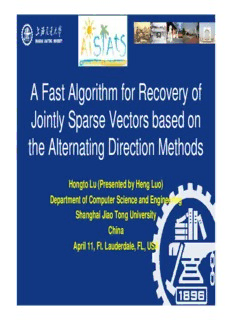
Our algorithm (MMV-ADM) PDF
Preview Our algorithm (MMV-ADM)
A Fast Algorithm for Recovery of Jointly Sparse Vectors based on the Alternating Direction Methods Hongto Lu (Presented by Heng Luo) Department of Computer Science and Engineering Shanghai Jiao Tong University China April 11, Ft. Lauderdale, FL, USA The author (Hongtao Lu) Cannot attend AISTATS2011 due to the Visa reason. Ask his colleague Mr. Heng Luo to give the talk in place of him Shanghai Jiao Tong University One of the top research University in China Outline Introduction Problem formulation Existing methods Our Algorithm Experiments Conclusion and future works Introduction Compressive sensing (CS) has recently emerged as an active research area which aims to recover sparse signals from measurement data (Candes et al., 2006; Donoho, 2006a). E. J. Candes, J. Romberg, and T. Tao (2006). Robust uncertainty principles: Exact signal reconstruction from highly incomplete frequency information. IEEE Transactions on Information Theory, 52(2): 489-509. D. L. Donoho (2006a). Compressed sensing. IEEE Transactions on Information Theory, 52(4):1289-1306. Introduction Single Measurement Vector Model (SMV) • The basic compressive sensing (CS) is a single measurement model, which aims to recover sparse signal from single measurement vector Sparse signal to be b = Ax recovered Measurement vector Dictionary Introduction Multiple Measurement Vector Model (MMV) • Recovery of sparse signals from multiple measurement vectors • In this paper, we consider the recovery of jointly sparse signals in the MMV model where multiple signal measurements are represented as a matrix and the sparsity of signal occurs in common locations. (Jointly) Sparse signals B = AX (matrix) to be Measurement recovered vectors (matrix) Dictionary Introduction MMV models arise in • Magnetoencephalography (MEG) • DNA microarrays • sparse communication channels • echo cancellation • sparse solutions to linear inverse problems • source localization in sensor networks • … Introduction Solving MMV model is much more difficult than solving SMV model Current methods are slow and not scale up well In this paper, we propose a fast algorithm for MMV model based on the alternating direction methods (ADM) which is much faster than the state-of-the-art method MMVprox. Outline Introduction and motivation Problem formulation Existing methods Our Algorithm Experiments Conclusion and future works
Description: